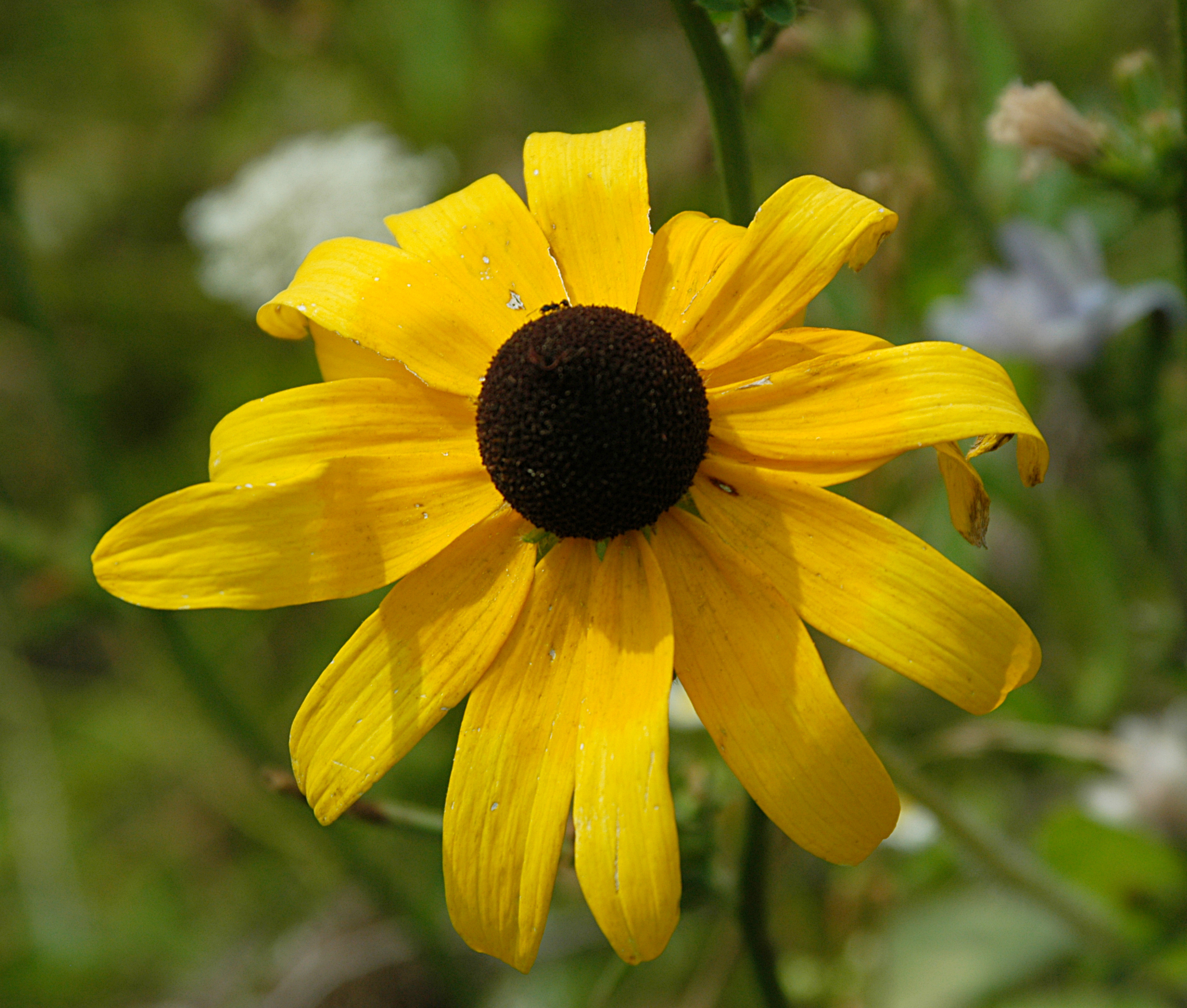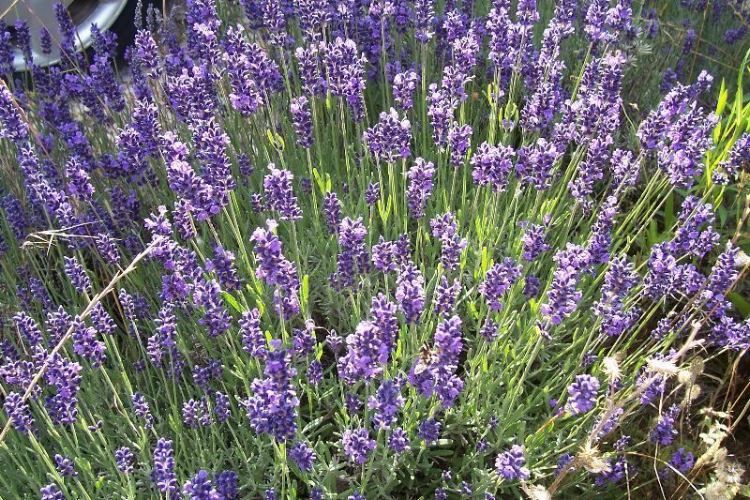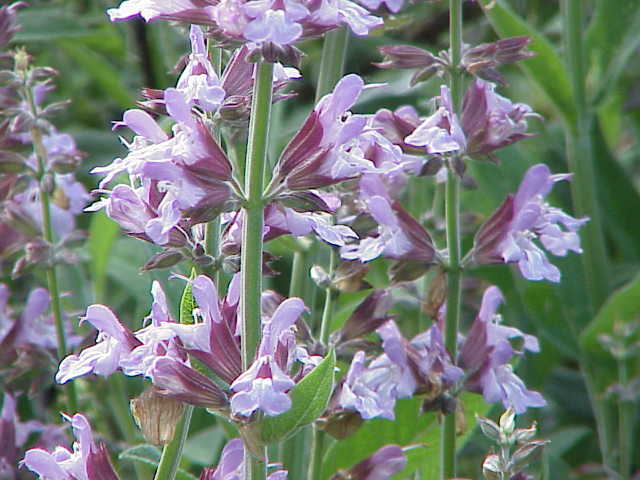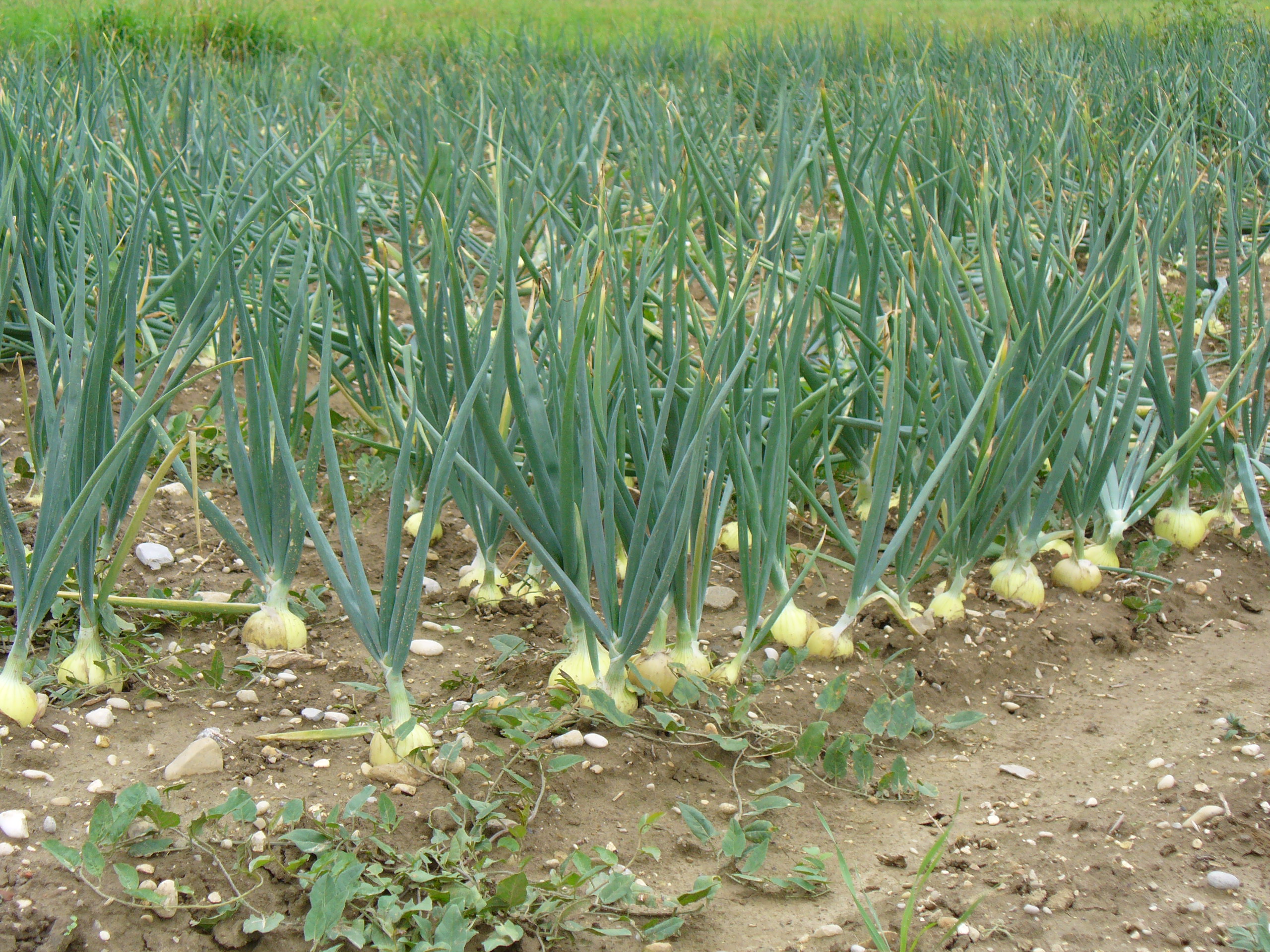Rudbeckia hirta, commonly called black-eyed Susan, is a species of flowering plant in the family Asteraceae, native to the Eastern and Central United States. It is one of a number of plants with the common name black-eyed Susan. Other common names for this plant include: brown-eyed Susan, brown Betty, gloriosa daisy, golden Jerusalem, Poorland daisy, yellow daisy, and yellow ox-eye daisy.
It is the state flower of Maryland.
The plant also is a traditional Native American medicinal herb in several tribal nations; believed in those cultures to be a remedy, among other things, for colds, flu, infection, swelling and (topically, by poultice) for snake bite (although not all parts of the plant are edible)
Parts of the plant have nutritional value. Other parts are not edible.
 R. hirta is widely cultivated in parks and gardens, for summer bedding schemes, borders, containers, wildflower gardens, prairie-style plantings and cut flowers. Numerous cultivars have been developed, of which 'Indian Summer'and 'Toto' have gained the Royal Horticultural Society's Award of Garden Merit. Other popular cultivars include 'Double Gold' and 'Marmalade'.
Gloriosa daisies are tetraploid cultivars having much larger flowers than the species, often doubled or with contrasting markings on the petals. They were first bred by Alfred Blakeslee of Smith College by applying colchicine to R. hirta seeds; Blakeslee's stock was further developed by W. Atlee Burpee and introduced to commerce at the 1957 Philadelphia Flower Show. Gloriosa daisies are generally treated as annuals or short-lived perennials and are typically grown from seed, though there are some named cultivars.
R. hirta is widely cultivated in parks and gardens, for summer bedding schemes, borders, containers, wildflower gardens, prairie-style plantings and cut flowers. Numerous cultivars have been developed, of which 'Indian Summer'and 'Toto' have gained the Royal Horticultural Society's Award of Garden Merit. Other popular cultivars include 'Double Gold' and 'Marmalade'.
Gloriosa daisies are tetraploid cultivars having much larger flowers than the species, often doubled or with contrasting markings on the petals. They were first bred by Alfred Blakeslee of Smith College by applying colchicine to R. hirta seeds; Blakeslee's stock was further developed by W. Atlee Burpee and introduced to commerce at the 1957 Philadelphia Flower Show. Gloriosa daisies are generally treated as annuals or short-lived perennials and are typically grown from seed, though there are some named cultivars.

Lavandula angustifolia (lavender or English lavender, though not native to England; also common lavender, true lavender, narrow-leaved lavender), formerly L. officinalis, is a flowering plant in the family Lamiaceae, native to the western Mediterranean, primarily the Pyrenees and other mountains in northern Spain.
 It is a strongly aromatic shrub growing as high as 1 to 2 metres (3.3 to 6.6 ft) tall. The leaves are evergreen, 2–6 centimetres (0.79–2.36 in) long, and 4–6 millimetres (0.16–0.24 in) broad. The flowers are pinkish-purple (lavender-coloured), produced on spikes 2–8 cm (0.79–3.15 in) long at the top of slender, leafless stems 10–30 cm (3.9–11.8 in) long.
It is a strongly aromatic shrub growing as high as 1 to 2 metres (3.3 to 6.6 ft) tall. The leaves are evergreen, 2–6 centimetres (0.79–2.36 in) long, and 4–6 millimetres (0.16–0.24 in) broad. The flowers are pinkish-purple (lavender-coloured), produced on spikes 2–8 cm (0.79–3.15 in) long at the top of slender, leafless stems 10–30 cm (3.9–11.8 in) long.
English lavender is commonly grown as an ornamental plant. It is popular for its colourful flowers, its fragrance and its ability to survive with low water consumption. It does not grow well in continuously damp soil. It is fairly tolerant of low temperatures, generally considered hardy to USDA zone 5. It tolerates acid soils but favours neutral to alkaline soils. In some conditions it can be short-lived.
 The flowers and leaves are used as an herbal medicine,either in the form of lavender oil or as an herbal tea. The flowers are also used as a culinary herb, most often as part of the French herb blend called herbes de Provence.
Lavender essential oil, when diluted with a carrier oil, is commonly used as a relaxant with massage therapy. Products for home use, such as lotions, eye pillows (including lavender flowers or the essential oil itself) and bath oils, etc., are also used. Both the petals and the oil are the most popular ingredients in handmade soap.
The flowers and leaves are used as an herbal medicine,either in the form of lavender oil or as an herbal tea. The flowers are also used as a culinary herb, most often as part of the French herb blend called herbes de Provence.
Lavender essential oil, when diluted with a carrier oil, is commonly used as a relaxant with massage therapy. Products for home use, such as lotions, eye pillows (including lavender flowers or the essential oil itself) and bath oils, etc., are also used. Both the petals and the oil are the most popular ingredients in handmade soap.
Salvia officinalis (sage, also called garden sage, or common sage) is a perennial, evergreen subshrub, with woody stems, grayish leaves, and blue to purplish flowers. It is a member of the family Lamiaceae and is native to the Mediterranean region, though it has naturalized in many places throughout the world. It has a long history of medicinal and culinary use, and in modern times as an ornamental garden plant. The common name "sage" is also used for a number of related and unrelated species.
 Cultivars are quite variable in size, leaf and flower color, and foliage pattern, with many variegated leaf types. The Old World type grows to approximately 2 ft (0.61 m) tall and wide, with lavender flowers most common, though they can also be white, pink, or purple. The plant flowers in late spring or summer. The leaves are oblong, ranging in size up to 2.5 in (6.4 cm) long by 1 in (2.5 cm) wide. Leaves are grey-green, rugose on the upper side, and nearly white underneath due to the many short soft hairs. Modern cultivars include leaves with purple, rose, cream, and yellow in many variegated combinations.
Cultivars are quite variable in size, leaf and flower color, and foliage pattern, with many variegated leaf types. The Old World type grows to approximately 2 ft (0.61 m) tall and wide, with lavender flowers most common, though they can also be white, pink, or purple. The plant flowers in late spring or summer. The leaves are oblong, ranging in size up to 2.5 in (6.4 cm) long by 1 in (2.5 cm) wide. Leaves are grey-green, rugose on the upper side, and nearly white underneath due to the many short soft hairs. Modern cultivars include leaves with purple, rose, cream, and yellow in many variegated combinations.

Winter savory (Satureja montana) is a perennial herb in the family Lamiaceae, native to warm temperate regions of southern Europe and Mediterranean.
It is a perenial plant growing to 16 in (41 cm) tall. The leaves are opposite, oval-lanceolate, 1–2 cm long and 5 mm broad. The flowers are white.
 Easy to grow, it makes an attractive border plant for any culinary herb garden. It requires six hours of sun a day in soil that drains well. S. montana 'Nana' is a dwarf cultivar. In temperate climates it goes dormant in winter, putting out leaves on the bare stems again in the spring – do not cut the plant back, all those stems which appear dead will leaf out again. It is hardy and has a low bunching habit.
Winter savory has been used for hundreds of years.
Easy to grow, it makes an attractive border plant for any culinary herb garden. It requires six hours of sun a day in soil that drains well. S. montana 'Nana' is a dwarf cultivar. In temperate climates it goes dormant in winter, putting out leaves on the bare stems again in the spring – do not cut the plant back, all those stems which appear dead will leaf out again. It is hardy and has a low bunching habit.
Winter savory has been used for hundreds of years.
 Both it and summer savory have been grown and used, virtually side by side. Both have strong spicy flavour. It goes particularly well with any type of mushroom, or in white sauces, and is very good in potato salads. Small amounts spice a regular salad well. It has a rich herbaceous aroma when crushed.
It is used as a companion plant for beans, keeping bean weevils away, and also roses, reducing mildew and aphids.
Both it and summer savory have been grown and used, virtually side by side. Both have strong spicy flavour. It goes particularly well with any type of mushroom, or in white sauces, and is very good in potato salads. Small amounts spice a regular salad well. It has a rich herbaceous aroma when crushed.
It is used as a companion plant for beans, keeping bean weevils away, and also roses, reducing mildew and aphids.
Solanum atropurpureum, commonly known as Malevolence, Purple Devil and the Five-Minute Plant, is a perennial herbaceous plant native to Brazil. S. atropurpureum contains various toxic tropane alkaloids in its fruit, stems and leaves and should not be ingested.
 The plant is a small shrub growing 1.2 to 1.8 meters in height and 90 to 120 cm in width with ovate, spade shaped leaves 5 to 10 cm long when fully grown. It blooms yellow to white flowers in the late spring to mid summer, and produces small (1–2 cm wide) orange fruit. The fruit's juices can be irritating to the touch, so it is recommended that gloves be used when removing or handling. The plant is characterized by its purple stems, which are completely covered by striking purple and green thorns about 2 cm long, from which its common names are ostensibly derived. The plant is short lived with a 3 to 5 year lifespan.
The plant is a small shrub growing 1.2 to 1.8 meters in height and 90 to 120 cm in width with ovate, spade shaped leaves 5 to 10 cm long when fully grown. It blooms yellow to white flowers in the late spring to mid summer, and produces small (1–2 cm wide) orange fruit. The fruit's juices can be irritating to the touch, so it is recommended that gloves be used when removing or handling. The plant is characterized by its purple stems, which are completely covered by striking purple and green thorns about 2 cm long, from which its common names are ostensibly derived. The plant is short lived with a 3 to 5 year lifespan.
 The plant can be grown ornamentally, requiring full sun and modest water. The plant is known to grow in a wide variety of soils and can resist temperatures as low as -10 degrees Celsius for a few days. Seeds can be harvested from the fruits, and stem cuttings can be used to grow the plant in about 10 to 20 days.
It is also known as a natural reservoir of the potato virus X.
The plant can be grown ornamentally, requiring full sun and modest water. The plant is known to grow in a wide variety of soils and can resist temperatures as low as -10 degrees Celsius for a few days. Seeds can be harvested from the fruits, and stem cuttings can be used to grow the plant in about 10 to 20 days.
It is also known as a natural reservoir of the potato virus X.
Solanum robustum, otherwise known as the Shrubby Nightshade, is a thorny perennial shrub native to northeastern South America of the genus Solanum and is therefore related to the potato and tomato plants.
 A medium shrub, the plant may grow 4 to 8 feet (1.2 - 2.4 m.) with velvety leaves and stems due to dense stellate trichomes present on all faces of the plant. Strong, straight or recurved flattened prickles up to 12 millimeters long may be found along the stems. The leaves grow 6 to 10 inches long and feature nine angled ridges along their perimeter. S. robustum blooms between late spring and mid fall with small clusters of white to yellow-white star shaped inflorescence followed by white or yellowish marble sized berries. S. robustum contains various tropane alkaloids in its leaves, fruit and stems and therefore should not be consumed.
A medium shrub, the plant may grow 4 to 8 feet (1.2 - 2.4 m.) with velvety leaves and stems due to dense stellate trichomes present on all faces of the plant. Strong, straight or recurved flattened prickles up to 12 millimeters long may be found along the stems. The leaves grow 6 to 10 inches long and feature nine angled ridges along their perimeter. S. robustum blooms between late spring and mid fall with small clusters of white to yellow-white star shaped inflorescence followed by white or yellowish marble sized berries. S. robustum contains various tropane alkaloids in its leaves, fruit and stems and therefore should not be consumed.

Lycianthes rantonnetii (blue potato bush) is a species of flowering plant in the family Solanaceae. It is native to Brazil, Bolivia, Argentina and Paraguay.Cultivated as ornamental the world over.
 The blue potato bush is one of about 150 species in the genus Lycianthes, which are found mostly in tropical regions of the Americas, and others located in the Asia-Pacific region. Lycianthes is apparently closely related to the chili peppers (Capsicum). However, it was long confused with the nightshades (Solanum), and several little-known Solanum species presumably should be included with Lycianthes.
The species is named for Barthélémy Victor Rantonnet, a 19th-century French horticulturalist.
The blue potato bush is one of about 150 species in the genus Lycianthes, which are found mostly in tropical regions of the Americas, and others located in the Asia-Pacific region. Lycianthes is apparently closely related to the chili peppers (Capsicum). However, it was long confused with the nightshades (Solanum), and several little-known Solanum species presumably should be included with Lycianthes.
The species is named for Barthélémy Victor Rantonnet, a 19th-century French horticulturalist.
Narcissus papyraceus (from papyrus and aceus; meaning paper-like), one of a few species known as "Paperwhite," is a perennial bulbous plant native to the western Mediterranean region, from Greece to Portugal plus Morocco and Algeria. The species is considered naturalized in the Azores, Corsica, Texas, California and Louisiana. The white flowers are borne in bunches and are strongly fragrant. It is frequently grown as a house plant, often forced to flower at Christmas.
Paperwhites are part of the Narcissus genus which includes plants known as daffodils.
 The stems are mid-green and grow upright. Mature height is usually 1–1.5 ft (30–45 cm), though this varies by variety. Several white flowers are borne at the top of each stem and are strongly scented.
The stems are mid-green and grow upright. Mature height is usually 1–1.5 ft (30–45 cm), though this varies by variety. Several white flowers are borne at the top of each stem and are strongly scented.
Many cultivars are available and are easy to force into bloom indoors. Unlike other Narcissus species, Paperwhites do not require chilling to promote bloom. The bulbs begin to grow as soon as they are planted, with flowers appearing in 3–4 weeks.
Narcissus papyraceus thrives in moist, peat moss based potting mix. Plants can also be grown in containers of water. Cool temperatures between 50–65 °F (10–18 °C) and indirect light will help to prolong the bloom time.
Tree onions, topsetting onions, walking onions, or Egyptian onions, Allium ×proliferum, are similar to common onions (A. cepa), but with a cluster of bulblets where a normal onion would have flowers. Genomic evidence has conclusively shown that they are a hybrid of the common onion and the Welsh onion (A. fistulosum). However, some sources may still treat the tree onion as A. cepa var. proliferum or A. cepa Proliferum Group. Tree onion bulblets will sprout and grow while still on the original stalk, which may bend down under the weight of the new growth and take root some distance from the parent plant, giving rise to the name "walking onion". It has been postulated that the name "Egyptian onion" is derived from tree onions being brought to Europe from the Indian subcontinent by the Romani people.
 The phenomenon of forming bulblets instead of flowers is also seen in garlic and other alliums, which sometimes may also be referred to as top onions or tree onions. The bulblets are usually marble-sized, between 0.5 cm to 3 cm in diameter.
Many tree onions are very strong flavoured, although some cultivars are relatively mild and sweet.The underground bulbs are particularly tough-skinned and pungent, and can be quite elongate, like leeks, or in some types may form bulbs up to 5 cm across. Young plants may be used as scallions in the spring, and the bulblets may be used in cooking similarly to regular onions, or preserved by pickling.
The phenomenon of forming bulblets instead of flowers is also seen in garlic and other alliums, which sometimes may also be referred to as top onions or tree onions. The bulblets are usually marble-sized, between 0.5 cm to 3 cm in diameter.
Many tree onions are very strong flavoured, although some cultivars are relatively mild and sweet.The underground bulbs are particularly tough-skinned and pungent, and can be quite elongate, like leeks, or in some types may form bulbs up to 5 cm across. Young plants may be used as scallions in the spring, and the bulblets may be used in cooking similarly to regular onions, or preserved by pickling.
The onion (Allium cepa) (Latin 'cepa' = onion), also known as the bulb onion or common onion, is used as a vegetable and is the most widely cultivated species of the genus Allium. This genus also contains several other species variously referred to as onions and cultivated for food, such as the Japanese bunching onion (A. fistulosum), the Egyptian onion (A. ×proliferum), and the Canada onion (A. canadense). The name "wild onion" is applied to a number of Allium species but A. cepa is exclusively known from cultivation and its ancestral wild original form is not known, although escapes from cultivation have become established in some regions. The onion is most frequently a biennial or a perennial plant, but is usually treated as an annual and harvested in its first growing season.
 Onions are best cultivated in fertile soils that are well-drained. Sandy loams are good as they are low in sulphur, while clayey soils usually have a high sulphur content and produce pungent bulbs. Onions require a high level of nutrients in the soil. Phosphorus is often present in sufficient quantities but may be applied before planting because of its low level of availability in cold soils. Nitrogen and potash can be applied at intervals during the growing season, the last application of nitrogen being at least four weeks before harvesting. Bulbing onions are day-length sensitive; their bulbs begin growing only after the number of daylight hours has surpassed some minimal quantity. Most traditional European onions are what is referred to as "long-day" onions, producing bulbs only after 14+ hours of daylight occurs.
Onions are best cultivated in fertile soils that are well-drained. Sandy loams are good as they are low in sulphur, while clayey soils usually have a high sulphur content and produce pungent bulbs. Onions require a high level of nutrients in the soil. Phosphorus is often present in sufficient quantities but may be applied before planting because of its low level of availability in cold soils. Nitrogen and potash can be applied at intervals during the growing season, the last application of nitrogen being at least four weeks before harvesting. Bulbing onions are day-length sensitive; their bulbs begin growing only after the number of daylight hours has surpassed some minimal quantity. Most traditional European onions are what is referred to as "long-day" onions, producing bulbs only after 14+ hours of daylight occurs.
Southern European and North African varieties are often known as "intermediate-day" types, requiring only 12–13 hours of daylight to stimulate bulb formation. Finally, "short-day" onions, which have been developed in more recent times, are planted in mild-winter areas in the fall and form bulbs in the early spring, and require only 11–12 hours of daylight to stimulate bulb formation.Onions are a cool-weather crop and can be grown in USDA zones 3 to 9.Hot temperatures or other stressful conditions cause them to "bolt", meaning that a flower stem begins to grow.






